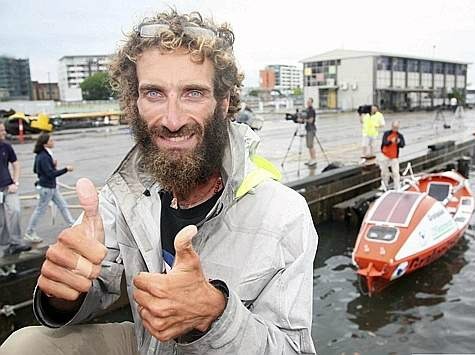An Italian adventurer and an American climate professor presented two contrasting faces of the global warming debate in January, with one vowing to live on an iceberg for a year and the other vowing to monitor Pacific Ocean circulation patterns.
Bellini: The Face of Global Warming
Italian adventurer Alex Bellini (at left) plans to live on an iceberg in a kevlar boat/shelter for eight to 12 months to “to demonstrate just how quickly things are changing” in the Arctic. His plan is to park his boat/shelter on an iceberg off Greenland this spring, and float around for a while “documenting the melting process as [the iceberg] disappears completely.”
Bellini might be up there a while. Arctic sea ice has increased 30 percent this winter from last year’s extent, and ice levels at both poles combined spent nearly all of 2013 above the long-term average.
Bellini can cherry-pick his iceberg to be one that sits along the southern band of sea ice. Such icebergs melt every spring, regardless of whether the earth warms, cools, or remains status quo. Bellini would only be dramatically “documenting” something that is entirely natural and happens every year.
Even if Arctic sea ice were melting, this would not usher in a global warming crisis. When sea ice melts, it does nothing to increase sea level.
One thing Bellini will nevertheless have to worry about is the growing global population of polar bears. Spending months all alone on an iceberg might make Bellini easier prey than the seals that dive under water at the first sight of a bear.
Easterbrook: The Face of Skepticism Meanwhile, Western Washington University professor emeritus Don Easterbrook (at left) correctly predicted back in 2000 that the 20-plus year warming trend of the time was coming to a halt and modest global cooling would ensue. In January 2014 Easterbrook told CNSNews the planet will likely undergo another two decades of modest cooling.
Meanwhile, Western Washington University professor emeritus Don Easterbrook (at left) correctly predicted back in 2000 that the 20-plus year warming trend of the time was coming to a halt and modest global cooling would ensue. In January 2014 Easterbrook told CNSNews the planet will likely undergo another two decades of modest cooling.
Easterbrook notes Pacific Ocean circulation patterns shift every 30 years or so, bringing warmer or cooler global temperatures with each shift. Don’t expect renewed warming, or accelerated melting of Arctic icebergs, until the Pacific Ocean circulation pattern shifts again, explains Easterbrook.
Jim Lakely ([email protected]) is communications director for The Heartland Institute.





